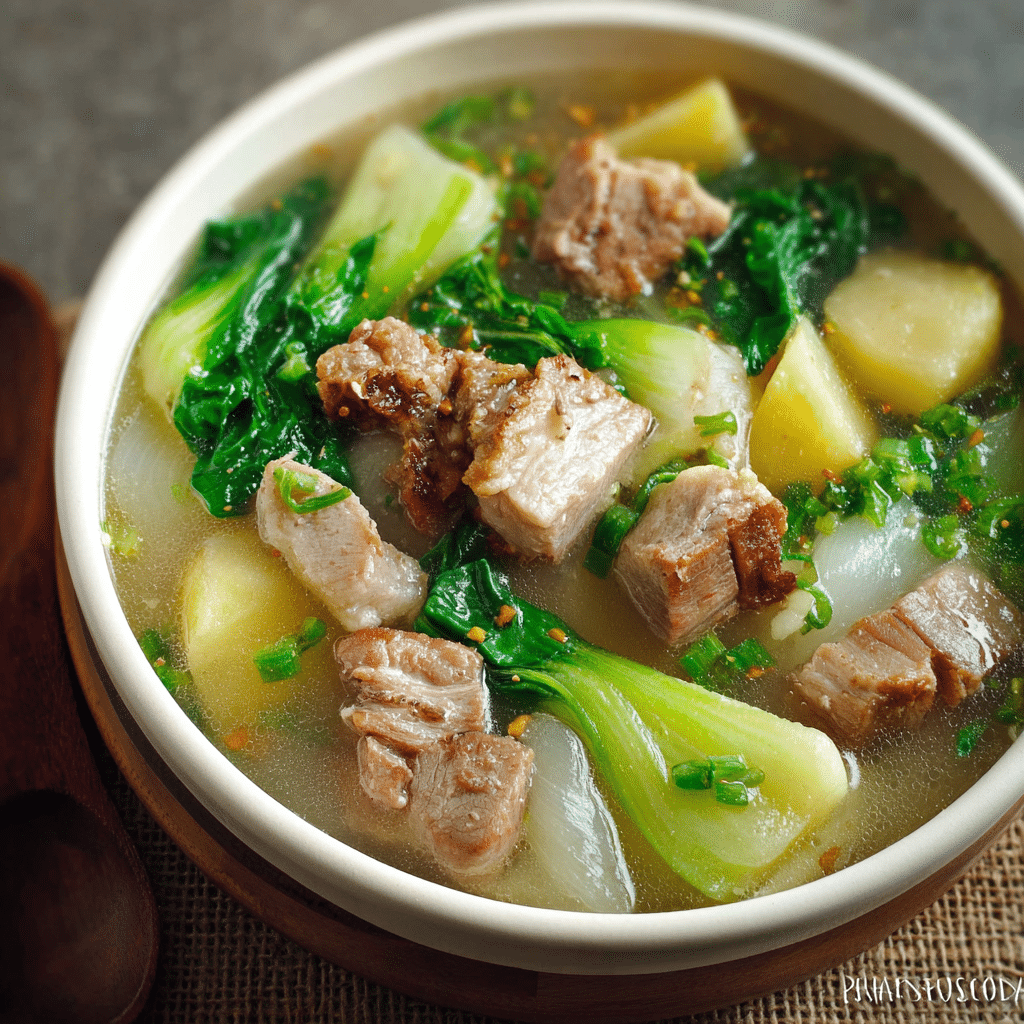The essence of Filipino home cooking comes alive in this humble yet hearty Pork Nilaga. Boiled slowly to perfection, the pork becomes meltingly tender, absorbing the light broth flavored with onions, peppercorns, and fish sauce. Root vegetables like potatoes provide a satisfying depth, while cabbage and bok choy add freshness and a pop of green.
Traditionally served with steamed rice, this soup is a staple comfort dish in many Filipino households. Whether you’re looking for a nostalgic taste of home or a new Asian-inspired dish to warm you up, Pork Nilaga is a flavorful, feel-good recipe that brings everyone to the table.
Full Recipe
Ingredients:
-
2 lbs pork belly or pork ribs, cut into chunks
-
1 onion, peeled and halved
-
1 tablespoon whole peppercorns
-
8 cups water
-
3 medium potatoes, peeled and quartered
-
1/2 head cabbage, chopped
-
1 bunch bok choy, trimmed
-
1 tablespoon fish sauce (optional)
-
Salt to taste
-
Green onions or chopped parsley (for garnish)
Directions:
-
In a large pot, combine pork, onion, peppercorns, and water. Bring to a boil over high heat.
-
Skim off scum that rises to the surface. Reduce heat to medium-low and simmer for about 45 minutes to 1 hour or until pork is tender.
-
Add potatoes and cook for another 10-15 minutes or until they’re fork-tender.
-
Stir in cabbage and cook for 3 minutes, followed by bok choy for an additional 2 minutes until just wilted.
-
Season with salt and fish sauce to taste.
-
Remove from heat, garnish with green onions or chopped parsley, and serve hot with steamed rice.
Prep Time: 10 minutes | Cooking Time: 1 hour | Total Time: 1 hour 10 minutes
Kcal: 380 kcal per serving | Servings: 6 servings
Introduction to Filipino Pork Nilaga
Filipino Pork Nilaga is a dish that truly embodies the spirit of Filipino comfort food. The word “nilaga” means “boiled” in Tagalog, and that’s exactly what this dish is—boiled pork simmered slowly in a clear broth with vegetables such as potatoes, cabbage, and bok choy. It’s simple, nourishing, and deeply satisfying. Often enjoyed on rainy days or as a warm family meal, Pork Nilaga holds a special place in the heart of many Filipinos. The simplicity of the dish is what makes it so universally loved: no fancy ingredients, just honest flavors created through patience and tradition.
What sets Nilaga apart from other Asian soups is its clean broth and subtle flavor. There’s no heavy seasoning, no coconut milk, and no spice overload. It’s a straightforward dish that relies on the quality of its ingredients and slow cooking to extract maximum flavor. The broth becomes rich and comforting thanks to the long, gentle simmering of pork bones and meat, often served with rice for a full, satisfying meal.
Cultural Significance of Nilaga in the Philippines
Pork Nilaga is more than just food; it is a cultural tradition. In Filipino homes, it’s common to see large pots of nilaga simmering on the stove on weekends or during family gatherings. The preparation of this dish often brings families together—not only to eat but to share stories, laugh, and connect. It is part of what Filipinos call “comfort food”, and many associate it with childhood memories and the warmth of home.
The dish reflects the Filipino approach to cooking: resourceful, communal, and soulful. Ingredients like pork belly, potatoes, and leafy greens are easily available in local markets, and the slow cooking process ensures that even less expensive cuts of meat turn into tender, flavorful bites. In rural provinces and urban households alike, nilaga is cherished as a go-to meal when the weather is cold, when someone is feeling under the weather, or simply when a wholesome dinner is needed.
The Flavor Profile and Texture of Pork Nilaga
Pork Nilaga has a delicate, clean flavor with a deeply savory essence. The pork, when simmered slowly, releases collagen and natural fats that enrich the broth without making it heavy or greasy. The peppercorns and onions add depth without overpowering the other ingredients, allowing each component to shine.
Texturally, the dish is satisfying and layered. The pork is fall-apart tender, the potatoes are soft but not mushy, and the leafy greens retain just the right amount of bite. The cabbage and bok choy absorb the broth beautifully, making each spoonful a mix of rich meat, tender veggies, and soul-soothing soup. Some people even enjoy it with a dash of fish sauce or calamansi juice added at the table to personalize the flavor to their liking.
Variations Across Regions and Households
Like many traditional Filipino dishes, there are countless variations of Pork Nilaga depending on region and family tradition. Some versions include corn on the cob, bananas (such as saba), or even green beans. Others prefer to use beef shank instead of pork, leading to a close relative of this dish called Nilagang Baka.
In some households, especially in the provinces, cooks might also add lemongrass or bay leaves to add a subtle aroma to the broth. Others choose to add bone marrow for extra richness, turning the soup into something even more luxurious. While purists stick to the core trio of pork, potatoes, and cabbage, many modern adaptations incorporate other seasonal vegetables, depending on what’s available.
Health Benefits and Nutritional Value
Pork Nilaga offers a surprisingly good mix of nutrients, especially when prepared with leaner cuts of pork and a variety of vegetables. The clear broth is hydrating and light, which is excellent for digestion. The pork provides a solid source of protein, while the cabbage, potatoes, and bok choy offer dietary fiber, vitamins, and minerals.
Bok choy, in particular, is rich in vitamin C, vitamin K, and calcium, while potatoes are a great source of potassium and energy-giving carbohydrates. Unlike richer stews or fried dishes, Nilaga is relatively low in fat—especially when fat is skimmed from the broth—and doesn’t contain any processed ingredients. It’s a dish that’s both comforting and nutritionally sound, making it a favorite among health-conscious home cooks.
Serving Suggestions and Pairings
Nilaga is traditionally served with freshly steamed white rice, which complements the broth perfectly and turns the soup into a hearty meal. Some people enjoy dipping the meat and vegetables in a side of soy sauce with crushed garlic, fish sauce with chili, or even a squeeze of calamansi for added zest.
To elevate your Nilaga meal, consider serving it alongside simple side dishes like ensaladang mangga (green mango salad), grilled eggplant, or even a cold dessert like leche flan or halo-halo. A hot bowl of Nilaga, paired with classic Filipino sides, creates a balanced dining experience that showcases the flavors of the Philippines in a delicious, unpretentious way.
Why Pork Nilaga Stands the Test of Time
In a world where culinary trends come and go, Pork Nilaga remains a timeless classic. Its resilience lies in its simplicity and heartwarming quality. Unlike heavily spiced or intricate dishes, Nilaga focuses on bringing out the best in a few ingredients. There are no shortcuts—just slow cooking, simple seasoning, and a deep respect for ingredients.
Even as younger generations explore new cuisines and cooking techniques, Nilaga remains a constant on the family table. It is often the dish that children request when they’re feeling sick, the meal that grandparents prepare for Sunday lunch, and the comfort food that overseas Filipinos crave when they miss home. It’s a recipe that teaches patience, shares culture, and reminds everyone at the table of where they come from.
Conclusion
Filipino Pork Nilaga is more than just a recipe—it is a living piece of culinary heritage. Its humble ingredients and slow cooking process make it a celebration of patience and tradition. Loved for its clean broth, tender pork, and nutritious vegetables, Nilaga is a dish that nourishes both body and soul. Whether enjoyed in a bustling family home in Manila or a quiet apartment halfway across the globe, it connects people through warmth, flavor, and shared memories.
So next time you’re looking for a recipe that brings comfort, simplicity, and deep cultural value to your table, make a pot of Pork Nilaga. Serve it with rice, gather your family, and let the aroma of this beloved dish bring everyone home—even if just for a meal.






